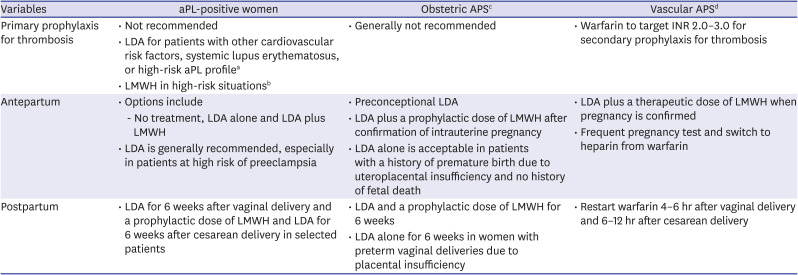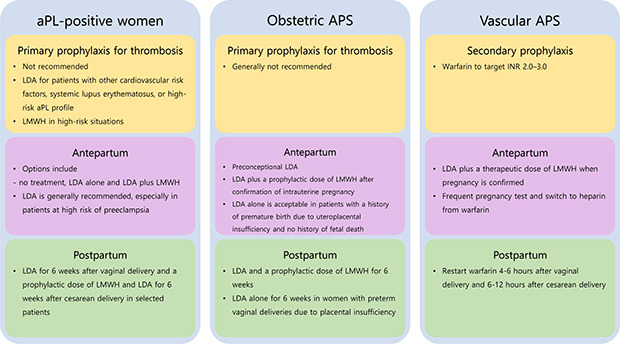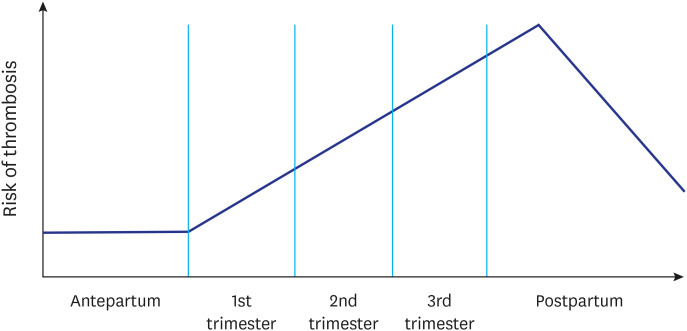1. Banzato A, Pengo V. Clinical relevance of β
2-glycoprotein-I plasma levels in antiphospholipid syndrome (APS). Curr Rheumatol Rep. 2014; 16(6):424. PMID:
24797512.


2. Yelnik CM, Lambert M, Drumez E, Le Guern V, Bacri JL, Guerra MM, et al. Bleeding complications and antithrombotic treatment in 264 pregnancies in antiphospholipid syndrome. Lupus. 2018; 27(10):1679–1686. PMID:
30016929.

3. Cervera R, Serrano R, Pons-Estel GJ, Ceberio-Hualde L, Shoenfeld Y, de Ramón E, et al. Morbidity and mortality in the antiphospholipid syndrome during a 10-year period: a multicentre prospective study of 1000 patients. Ann Rheum Dis. 2015; 74(6):1011–1018. PMID:
24464962.


4. Bramham K, Hunt BJ, Germain S, Calatayud I, Khamashta M, Bewley S, et al. Pregnancy outcome in different clinical phenotypes of antiphospholipid syndrome. Lupus. 2010; 19(1):58–64. PMID:
19897518.


5. Meroni PL, Borghi MO, Grossi C, Chighizola CB, Durigutto P, Tedesco F. Obstetric and vascular antiphospholipid syndrome: same antibodies but different diseases? Nat Rev Rheumatol. 2018; 14(7):433–440. PMID:
29891914.


6. Arachchillage DR, Machin SJ, Mackie IJ, Cohen H. Diagnosis and management of non-criteria obstetric antiphospholipid syndrome. Thromb Haemost. 2015; 113(1):13–19. PMID:
25318976.


7. Miyakis S, Lockshin MD, Atsumi T, Branch DW, Brey RL, Cervera R, et al. International consensus statement on an update of the classification criteria for definite antiphospholipid syndrome (APS). J Thromb Haemost. 2006; 4(2):295–306. PMID:
16420554.


8. Atanassova PA. Antiphospholipid syndrome and vascular ischemic (occlusive) diseases: an overview. Yonsei Med J. 2007; 48(6):901–926. PMID:
18159581.



9. Heit JA, Kobbervig CE, James AH, Petterson TM, Bailey KR, Melton LJ 3rd. Trends in the incidence of venous thromboembolism during pregnancy or postpartum: a 30-year population-based study. Ann Intern Med. 2005; 143(10):697–706. PMID:
16287790.


10. Bang SM, Jang MJ, Kim KH, Yhim HY, Kim YK, Nam SH, et al. Prevention of venous thromboembolism, 2nd Edition: Korean Society of Thrombosis and Hemostasis evidence-based clinical practice guidelines. J Korean Med Sci. 2014; 29(2):164–171. PMID:
24550640.



11. Bates SM, Greer IA, Hirsh J, Ginsberg JS. Use of antithrombotic agents during pregnancy: the Seventh ACCP Conference on Antithrombotic and Thrombolytic Therapy. Chest. 2004; 126(3 Suppl):627S–644S. PMID:
15383488.
12. American College of Obstetricians and Gynecologists' Committee on Practice Bulletins—Obstetrics. 196: Thromboembolism in pregnancy. Obstet Gynecol. 2018; 132(1):e1–17. PMID:
29939938.
13. James AH, Jamison MG, Brancazio LR, Myers ER. Venous thromboembolism during pregnancy and the postpartum period: incidence, risk factors, and mortality. Am J Obstet Gynecol. 2006; 194(5):1311–1315. PMID:
16647915.


14. Barbhaiya M, Erkan D. Primary thrombosis prophylaxis in antiphospholipid antibody-positive patients: where do we stand? Curr Rheumatol Rep. 2011; 13(1):59–69. PMID:
21104348.


15. Arnaud L, Mathian A, Ruffatti A, Erkan D, Tektonidou M, Cervera R, et al. Efficacy of aspirin for the primary prevention of thrombosis in patients with antiphospholipid antibodies: an international and collaborative meta-analysis. Autoimmun Rev. 2014; 13(3):281–291. PMID:
24189281.


16. Erkan D, Harrison MJ, Levy R, Peterson M, Petri M, Sammaritano L, et al. Aspirin for primary thrombosis prevention in the antiphospholipid syndrome: a randomized, double-blind, placebo-controlled trial in asymptomatic antiphospholipid antibody-positive individuals. Arthritis Rheum. 2007; 56(7):2382–2391. PMID:
17599766.


17. Ruffatti A, Del Ross T, Ciprian M, Bertero MT, Sciascia S, Scarpato S, et al. Risk factors for a first thrombotic event in antiphospholipid antibody carriers: a prospective multicentre follow-up study. Ann Rheum Dis. 2011; 70(6):1083–1086. PMID:
21285115.


18. Girón-González JA, García del Río E, Rodríguez C, Rodríguez-Martorell J, Serrano A. Antiphospholipid syndrome and asymptomatic carriers of antiphospholipid antibody: prospective analysis of 404 individuals. J Rheumatol. 2004; 31(8):1560–1567. PMID:
15290736.

19. Fanouriakis A, Kostopoulou M, Alunno A, Aringer M, Bajema I, Boletis JN, et al. 2019 update of the EULAR recommendations for the management of systemic lupus erythematosus. Ann Rheum Dis. 2019; 78(6):736–745. PMID:
30926722.


20. Wahl DG, Bounameaux H, de Moerloose P, Sarasin FP. Prophylactic antithrombotic therapy for patients with systemic lupus erythematosus with or without antiphospholipid antibodies: do the benefits outweigh the risks? A decision analysis. Arch Intern Med. 2000; 160(13):2042–2048. PMID:
10888978.

21. Ruiz-Irastorza G, Cuadrado MJ, Ruiz-Arruza I, Brey R, Crowther M, Derksen R, et al. Evidence-based recommendations for the prevention and long-term management of thrombosis in antiphospholipid antibody-positive patients: report of a task force at the 13th International Congress on Antiphospholipid Antibodies. Lupus. 2011; 20(2):206–218. PMID:
21303837.


22. Choi H, Ahn SS, Song JJ, Park YB, Song J, Lee SW. Anti-phospholipid antibody syndrome occurrence in patients with persistent anti-phospholipid antibodies. Rheumatol Int. 2019; 39(8):1359–1367. PMID:
31076830.


23. Ceccarelli F, Chighizola C, Finazzi G, Meroni PL, Valesini G. Thromboprophylaxis in carriers of antiphospholipid antibodies (APL) without previous thrombosis: “Pros” and “Cons”. Autoimmun Rev. 2012; 11(8):568–571. PMID:
22036825.


24. Del Ross T, Ruffatti A, Visentin MS, Tonello M, Calligaro A, Favaro M, et al. Treatment of 139 pregnancies in antiphospholipid-positive women not fulfilling criteria for antiphospholipid syndrome: a retrospective study. J Rheumatol. 2013; 40(4):425–429. PMID:
23418380.


25. Derksen RH, Khamashta MA, Branch DW. Management of the obstetric antiphospholipid syndrome. Arthritis Rheum. 2004; 50(4):1028–1039. PMID:
15077285.


26. Blank M, Cohen J, Toder V, Shoenfeld Y. Induction of anti-phospholipid syndrome in naive mice with mouse lupus monoclonal and human polyclonal anti-cardiolipin antibodies. Proc Natl Acad Sci U S A. 1991; 88(8):3069–3073. PMID:
2014226.



27. Lynch A, Marlar R, Murphy J, Davila G, Santos M, Rutledge J, et al. Antiphospholipid antibodies in predicting adverse pregnancy outcome. A prospective study. Ann Intern Med. 1994; 120(6):470–475. PMID:
8093135.


28. Fishman P, Falach-Vaknin E, Sredni B, Meroni PL, Rudniki C, Shoenfeld Y. Aspirin modulates interleukin-3 production: additional explanation for the preventive effects of aspirin in antiphospholipid antibody syndrome. J Rheumatol. 1995; 22(6):1086–1090. PMID:
7674234.

29. Tincani A, Branch W, Levy RA, Piette JC, Carp H, Rai RS, et al. Treatment of pregnant patients with antiphospholipid syndrome. Lupus. 2003; 12(7):524–529. PMID:
12892392.

30. Gibbins KJ, Ware Branch D. Pre-eclampsia as a manifestation of antiphospholipid syndrome: assessing the current status. Lupus. 2014; 23(12):1229–1231. PMID:
25228712.


31. Kamel H, Navi BB, Sriram N, Hovsepian DA, Devereux RB, Elkind MS. Risk of a thrombotic event after the 6-week postpartum period. N Engl J Med. 2014; 370(14):1307–1315. PMID:
24524551.

32. Sultan AA, Tata LJ, West J, Fiaschi L, Fleming KM, Nelson-Piercy C, et al. Risk factors for first venous thromboembolism around pregnancy: a population-based cohort study from the United Kingdom. Blood. 2013; 121(19):3953–3961. PMID:
23550034.


33. Blondon M, Casini A, Hoppe KK, Boehlen F, Righini M, Smith NL. Risks of venous thromboembolism after cesarean sections: a meta-analysis. Chest. 2016; 150(3):572–596. PMID:
27262227.


34. Bates SM, Greer IA, Middeldorp S, Veenstra DL, Prabulos AM, Vandvik PO. VTE, thrombophilia, antithrombotic therapy, and pregnancy: antithrombotic therapy and prevention of thrombosis, 9th ed: American College of Chest Physicians evidence-based clinical practice guidelines. Chest. 2012; 141(2 Suppl):e691S–e736S. PMID:
22315276.
37. Danowski A, Rego J, Kakehasi AM, Funke A, Carvalho JF, Lima IV, et al. Guidelines for the treatment of antiphospholipid syndrome. Rev Bras Reumatol. 2013; 53(2):184–192. PMID:
23856795.


38. Erkan D, Merrill JT, Yazici Y, Sammaritano L, Buyon JP, Lockshin MD. High thrombosis rate after fetal loss in antiphospholipid syndrome: effective prophylaxis with aspirin. Arthritis Rheum. 2001; 44(6):1466–1467. PMID:
11407709.


39. Schreiber K, Sciascia S, de Groot PG, Devreese K, Jacobsen S, Ruiz-Irastorza G, et al. Antiphospholipid syndrome. Nat Rev Dis Primers. 2018; 4(1):17103. PMID:
29321641.


40. Espinosa G, Cervera R. Current treatment of antiphospholipid syndrome: lights and shadows. Nat Rev Rheumatol. 2015; 11(10):586–596. PMID:
26122952.


41. Uthman I, Noureldine MHA, Ruiz-Irastorza G, Khamashta M. Management of antiphospholipid syndrome. Ann Rheum Dis. 2019; 78(2):155–161. PMID:
30282668.


42. van Hoorn ME, Hague WM, van Pampus MG, Bezemer D, de Vries JI. FRUIT Investigators. Low-molecular-weight heparin and aspirin in the prevention of recurrent early-onset pre-eclampsia in women with antiphospholipid antibodies: the FRUIT-RCT. Eur J Obstet Gynecol Reprod Biol. 2016; 197:168–173. PMID:
26771908.


43. Arya R. How I manage venous thromboembolism in pregnancy. Br J Haematol. 2011; 153(6):698–708. PMID:
21501137.


44. US Food and Drug Administration. FDA drug safety communication: updated recommendations to decrease risk of spinal column bleeding and paralysis in patients on low molecular weight heparins. Updated 2013. Accessed March 25, 2019.
https://www.fda.gov/media/87316/download.
45. Hwang HG, Koo SM, Uh ST, Kim YK. The perioperative management of antithrombotic therapies using enoxaparin. J Korean Med Sci. 2017; 32(6):942–947. PMID:
28480651.



47. Grab D, Paulus WE, Erdmann M, Terinde R, Oberhoffer R, Lang D, et al. Effects of low-dose aspirin on uterine and fetal blood flow during pregnancy: results of a randomized, placebo-controlled, double-blind trial. Ultrasound Obstet Gynecol. 2000; 15(1):19–27. PMID:
10776008.


48. Miyazaki M, Kuwabara Y, Takeshita T. Influence of perinatal low-dose acetylsalicylic acid therapy on fetal hemodynamics evaluated by determining the acceleration-time/ejection-time ratio in the ductus arteriosus. J Obstet Gynaecol Res. 2018; 44(1):87–92. PMID:
28984005.


49. Hirsh J, Guyatt G, Albers GW, Harrington R, Schunemann HJ. Executive summary: American College of Chest Physicians Evidence-Based Clinical Practice Guidelines (8th Edition). Chest. 2008; 133(6 Suppl):71S–109S. PMID:
18574259.
50. Horlocker TT, Vandermeuelen E, Kopp SL, Gogarten W, Leffert LR, Benzon HT. Regional anesthesia in the patient receiving antithrombotic or thrombolytic therapy: American Society of Regional Anesthesia and Pain Medicine Evidence-Based Guidelines (Fourth Edition). Reg Anesth Pain Med. 2018; 43(3):263–309. PMID:
29561531.


51. Nam SW, Cho SK, Kim D, Lee KE, Park DJ, Lee SS, et al. Antiphospholipid antibody positivity and the clinical outcomes of patients with systemic lupus erythematosus. J Rheum Dis. 2018; 25(4):239–247.

52. Mok CC, Tang SS, To CH, Petri M. Incidence and risk factors of thromboembolism in systemic lupus erythematosus: a comparison of three ethnic groups. Arthritis Rheum. 2005; 52(9):2774–2782. PMID:
16142761.


53. Taraborelli M, Leuenberger L, Lazzaroni MG, Martinazzi N, Zhang W, Franceschini F, et al. The contribution of antiphospholipid antibodies to organ damage in systemic lupus erythematosus. Lupus. 2016; 25(12):1365–1368. PMID:
26945023.


54. Sammaritano LR, Bermas BL, Chakravarty EE, Chambers C, Clowse ME, Lockshin MD, et al. 2020 American College of Rheumatology Guideline for the management of reproductive health in rheumatic and musculoskeletal diseases. Arthritis Rheumatol. 2020; 72(4):529–556. PMID:
32090480.


55. Nicole Tran H, Klatsky AL. Lower risk of venous thromboembolism in multiple Asian ethnic groups. Prev Med Rep. 2019; 13:268–269. PMID:
30723661.



56. Jang MJ, Bang SM, Oh D. Incidence of venous thromboembolism in Korea: from the Health Insurance Review and Assessment Service database. J Thromb Haemost. 2011; 9(1):85–91. PMID:
20942850.


57. Lee CH, Lin LJ, Cheng CL, Kao Yang YH, Chen JY, Tsai LM. Incidence and cumulative recurrence rates of venous thromboembolism in the Taiwanese population. J Thromb Haemost. 2010; 8(7):1515–1523. PMID:
20345707.


58. Hwang JJ, Shin SH, Kim YJ, Oh YM, Lee SD, Kim YH, et al. Epidemiology of antiphospholipid syndrome in Korea: a nationwide population-based study. J Korean Med Sci. 2020; 35(5):e35. PMID:
32030922.








 PDF
PDF Citation
Citation Print
Print






 XML Download
XML Download